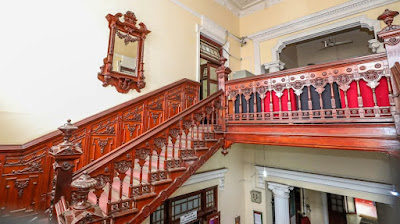Gampaha Agra Walawwa
Gampaha Agra Walawwa
The Agra Walawwa is a highly distinctive building located in Gampaha. It was built by Mr. D.D. Karunaratne, also known as Meneripitiya Appuhamilage Don David Karunaratne, a resident of Gampaha. Construction began in the late 1920s and was completed in the 1930s. According to popular belief, the house was named "Agra" because the craftsmen who constructed it came from Agra, a city in the Indian state of Uttar Pradesh, and the architecture follows Indian design styles.
Mr. David Karunaratne was a prominent plantation owner, possessing vast rubber and coconut estates, including the coconut estate at Bandiyamulla, Gampaha. A well-known philanthropist and social worker, he also donated the original buildings of Ratnavali Balika Vidyalaya and some of the old structures of the Gampaha District Hospital.
He was a founding member of the United National Party, established on September 6, 1946. In Sri Lanka’s (then Ceylon) first parliamentary election held in 1947, he contested the Gampaha seat under the UNP banner, securing 11,786 votes—38% of the valid votes—and entered Parliament. He was the father of two daughters, Chandra and Edith. Chandra married Percy Chandrasoma Jayakody, a member of the Divilapitiya Jayakody family. Percy was a former Member of Parliament for Divilapitiya (elected in 1960 under the UNP) and a relative of former Minister Lakshman Jayakody. Edith married Mr. Bertie Gunasekara, also known as A.E.C.D.S. Gunasekara, who at the time was Director of the Department of Irrigation and a resident of Horton Place, Colombo 07. Since Mr. Karunaratne had no sons, and both daughters—Edith first and later Chandra Jayakody in 2006—passed away, the Karunaratne lineage came to an end.
Many of the original elegant architectural features and fine wooden carvings, along with antique furniture, are still visible in the Walawwa. Among these are carved wooden dressing tables and wardrobes, inspired by popular local folk tales. The carvings depict stories such as the fox and the vine, and the crow and the cashew nut. The ceiling features floral and fruit motifs. A notable highlight is the beautiful glass-paneled mirrors embedded in the walls along the staircase to the upper floor. The courtyard is decorated with vintage clay tiles, which enhance the building’s charm. The wooden handrails are ornately carved, casting a unique glow throughout the mansion. The aesthetic and archaeological value of this grand house remains undiminished to this day.
The Walawwa also holds a special place in Sri Lankan cinema history. It was the main filming location for "Parasathu Mal" a cinematic masterpiece produced by Chitra Balasuriya in 1966 and directed by Gamini Fonseka, who also played the lead role. Other scenes for the film were shot at the Jayakody Walawwa in Ganemulla, Gampaha. In 1978, the government purchased the Agra Walawwa along with 12 acres of land for Rs. 1,530,000 for use by the Gampaha District Secretariat. Since then, the Walawwa, no longer under the Karunaratne family, has been serving the public as the official premises of the Gampaha District Secretariat.













Comments
Post a Comment